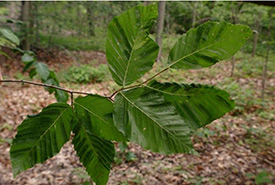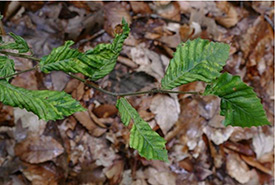Beech leaf disease: A new problem for Ontario trees

Early-stage leaf striping (Photo by John Pogacnik, Ohio Department of Natural Resources)
Beech bark disease began ravaging beech trees in Ontario in the late 1990s, after spreading west from Atlantic Canada. But recently, a new beech disease has emerged in the province. Beech leaf disease was first detected in North America in 2012 in Lake County, Ohio. It has since spread rapidly to other Ohio counties, Pennsylvania, New York and Ontario. This new disease was discovered in Elgin County, Ontario, in 2017 and has since been detected in four additional counties: Norfolk, Middlesex, Chatham-Kent and Oxford.
At this time, little is known about this disease, including where it came from, what causes it or how it affects the trees. Research continues on how beech leaf disease is caused and spread.
From 2012 to 2016, beech leaf disease spread at a rate of 1,250 acres (506 hectares) per year in one Ohio county. The disease seems to be in a rapid expansion phase, similar to what has been seen with other invasive species, such as emerald ash borer. In many of the areas infected with beech leaf disease, there are already visible changes in the tree canopy.
Related blog posts
Beech leaf disease appears to affect the trees’ ability to photosynthesize. Symptoms can be seen only on the leaves and buds of beech trees, and they are present from the time buds emerge in the spring. The leaves from infected trees appear to be striped, with darkening between the leaf veins. The darkened area is slightly raised and thicker than the rest of the leaf tissue. As the disease progresses, leaves near the branch tips become shriveled, discoloured and deformed, and fewer buds and leaves are produced.

Late-stage leaf deformation (Photo by John Pogacnik, Ohio Department of Natural Resources)
Disease progression varies based on tree size, with most overall tree deaths occurring in saplings. In larger trees, the disease progresses much more slowly. In this case, single branches may appear unaffected, while others are heavily infected. Infected trees also seem to be more susceptible to other beech-related pathogens, such as beech blight aphid, European beech scale, erineum patches (patches found on beech leaves caused by the eriophyid mite) and other fungi. This can make detecting beech leaf disease a challenge.
As little is known about the origin or biology of the disease, no effective control or eradication measures have yet been developed. Management efforts for beech leaf disease should focus on preventing the introduction of the invasive pathogen. More research must be conducted on determining the cause of the disease, so that these types of preventative measures can be developed.
Quarantines can be used to prevent further the spread of the disease, allowing researchers time to determine causes and effective control measures. In general, the spread of invasive species can be prevented by restricting the movement of firewood and wood products, monitoring trees closely for signs and symptoms, increasing the diversity of tree species and implementing management practices to keep forests healthy.
The public can assist in preventing the spread of invasive species by knowing the signs and symptoms of beech leaf disease and other pests, being aware of at-risk trees in their area and buying firewood cut from local trees. Other measures that can be taken to protect our forests include taking tree inventories, staying up-to-date on forest pests, reporting sightings and supporting local biodiversity.
Learn more about invasive species threatening Canada’s natural spaces by signing up to receive bi-weekly email updates on recent invasive species media and research, information on upcoming events and a quarterly newsletter from the Invasive Species Centre.
If you think you’ve seen beech leaf disease or another invasive species, report it!


